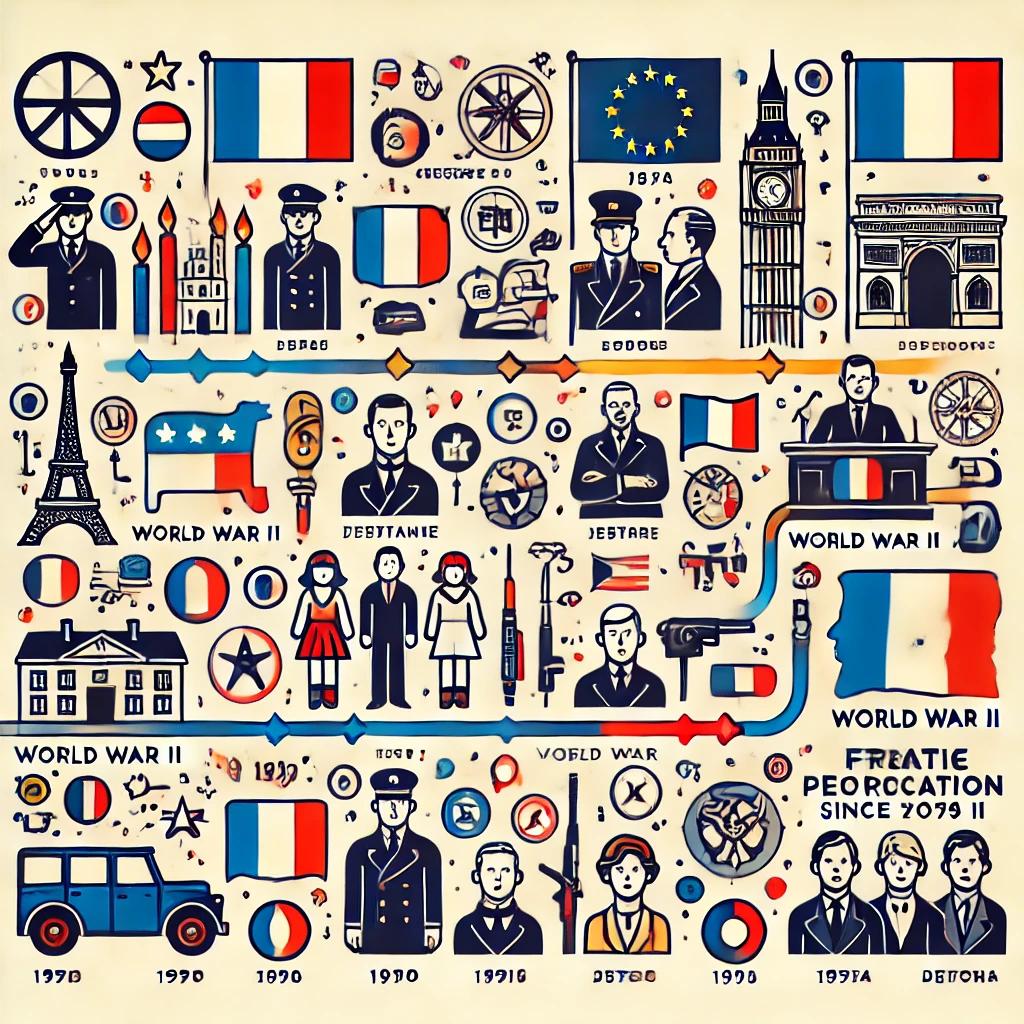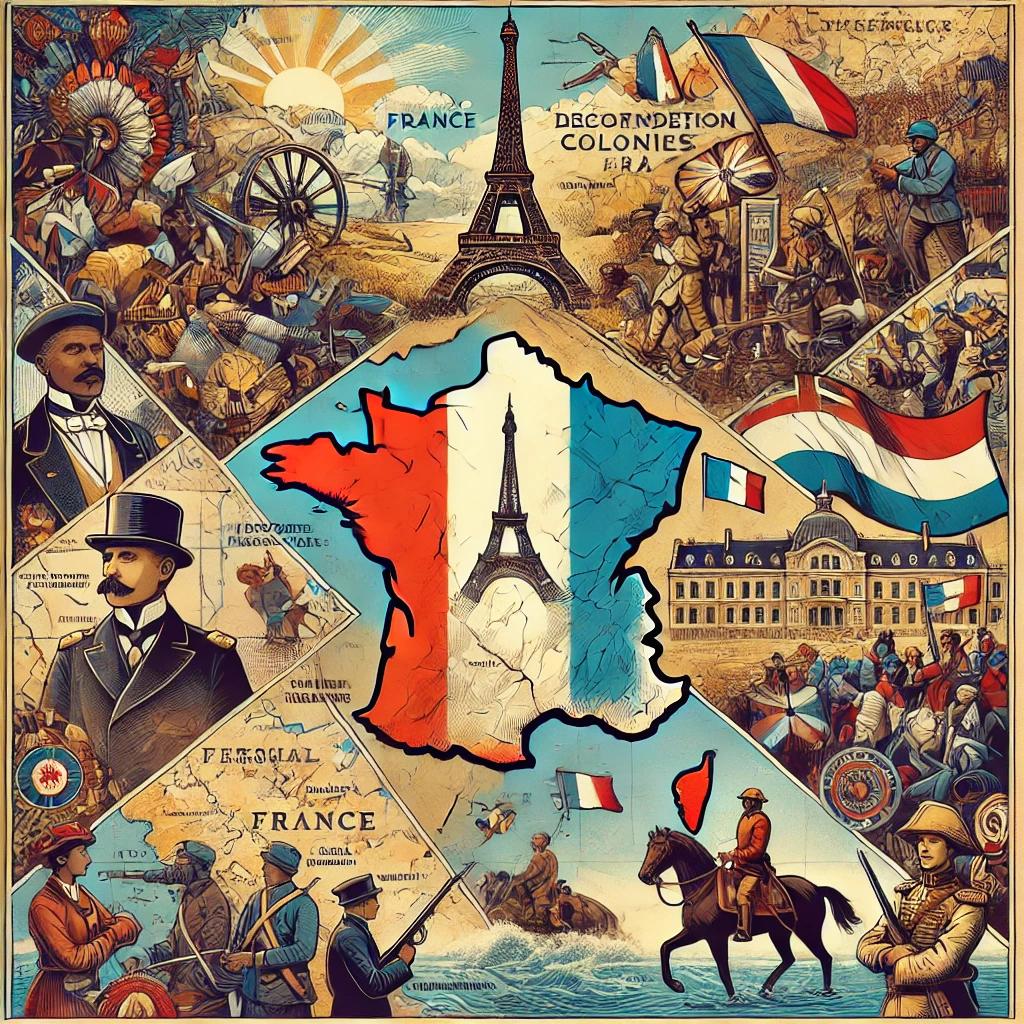
Introduction to Post-War France
In the aftermath of World War II, France found itself grappling with a multitude of challenges that would shape its political landscape for decades to come. The economic devastation wrought by years of conflict left the nation struggling to rebuild its infrastructure and revive its industries. The social atmosphere was equally fraught, characterized by a deep sense of uncertainty and the urgent need for reconstruction and rehabilitation. This period of instability created fertile ground for significant political transformations.
The immediate post-war era saw France under the provisional leadership of Charles de Gaulle, a key figure whose influence would be pivotal in the country’s recovery and political reformation. De Gaulle’s vision for a resilient and modern France was instrumental in steering the nation through its initial tumultuous years. His leadership during this critical juncture helped to lay the groundwork for the establishment of the Fourth Republic in 1946, a new political regime aimed at restoring order and democratic governance.
However, the Fourth Republic faced its own set of challenges, including political fragmentation and frequent governmental changes, which underscored the persistent instability within the French political system. The economic hardships continued to strain the social fabric, leading to widespread discontent and demands for more substantial reforms. The political scene was marked by the rise of various movements and parties, each vying to address the nation’s pressing issues and steer France towards a more stable and prosperous future.
In this context, the role of Charles de Gaulle remained a central theme in the narrative of post-war France. His efforts to unify the country and his eventual return to power in 1958 marked a significant turning point, transitioning France from the Fourth Republic to the Fifth Republic. This period of transformation underscored the dynamic and evolving nature of the French political system, setting the stage for future developments and reforms that would continue to shape the nation.
The Fourth Republic: 1946-1958
The establishment of the Fourth Republic in 1946 marked a significant transition in French political history. Following the liberation from Nazi occupation, there was a collective aspiration to rebuild and stabilize the nation. The Fourth Republic was characterized by a parliamentary system with a bicameral legislature, consisting of the National Assembly and the Council of the Republic. This structure aimed to prevent the concentration of power and foster a more democratic governance model.
However, the Fourth Republic faced significant challenges almost from its inception. One of the most notable issues was the frequent changes in government. Between 1946 and 1958, there were 24 different administrations, resulting in a lack of continuity and persistent political instability. The fragmentation of political parties further exacerbated this instability, making it difficult to form cohesive and lasting coalitions. This period saw an array of political figures and parties vying for influence, but often with conflicting agendas.
Key policies during the Fourth Republic focused on post-war recovery and modernization. Efforts were made to revive the economy through initiatives such as the Monnet Plan, which aimed to rebuild and industrialize France’s economy. Social reforms were also introduced, including improvements in social security and education. Despite these efforts, the political landscape remained tumultuous, undermining the effectiveness of these policies.
A pivotal event that underscored the fragility of the Fourth Republic was the Algerian War of Independence. Starting in 1954, the conflict became a major crisis that deeply divided French society and politics. The war highlighted the inadequacies of the Fourth Republic’s political system in managing colonial issues and maintaining order. The inability to resolve the Algerian conflict and other pressing issues led to a loss of confidence in the government.
The culmination of these ongoing crises and the inherent structural weaknesses ultimately led to the downfall of the Fourth Republic. By 1958, the political instability had reached a breaking point, paving the way for the establishment of the Fifth Republic under Charles de Gaulle, which promised a more stable and robust governance framework.
The Rise of Charles de Gaulle and the Fifth Republic
The post-World War II political landscape in France was tumultuous, characterized by instability and frequent governmental changes under the Fourth Republic. This period of uncertainty set the stage for the return of Charles de Gaulle in 1958, a pivotal moment that led to the establishment of the Fifth Republic. De Gaulle, a prominent leader of the Free French Forces during the war, was seen as a stabilizing figure who could navigate France through its political crisis.
Upon his return, de Gaulle introduced a new constitution, which was ratified by a referendum on September 28, 1958. This constitution marked a significant departure from the parliamentary system of the Fourth Republic, instituting a semi-presidential system that centralized power within the executive branch. The president, elected by popular vote, was endowed with substantial authority, including the capacity to dissolve the National Assembly, appoint the Prime Minister, and preside over the Council of Ministers. This shift aimed to provide stronger leadership and reduce the frequent governmental turnovers that had plagued the previous republic.
De Gaulle’s vision for France was deeply rooted in the principles of national sovereignty and independence. He sought to restore France’s grandeur on the international stage, advocating for a foreign policy that was independent of both the United States and the Soviet Union. Domestically, de Gaulle’s policies were geared towards economic modernization and social stability, setting the groundwork for France’s future growth and development.
The creation of the Fifth Republic also led to the centralization of power, not just in the executive branch, but across various state institutions. This centralization was seen as a means to streamline decision-making processes and enhance governmental efficiency. De Gaulle’s impact on the French political landscape was profound, not only stabilizing the nation during a critical period but also laying the foundations for a political system that endures to this day. His legacy is reflected in the continued strength and stability of the Fifth Republic, which has proven resilient through numerous political challenges over the decades.
Political Reforms and Changes in the 1970s and 1980s
The 1970s and 1980s were transformative decades for the French political system, marked by significant reforms and shifts. Under the leadership of Presidents Georges Pompidou, Valéry Giscard d’Estaing, and François Mitterrand, France experienced notable changes in its political landscape.
Georges Pompidou, who served as President from 1969 until his death in 1974, continued the Gaullist tradition but introduced modernization policies. His tenure saw the promotion of industrial growth and the expansion of the welfare state. Pompidou emphasized economic modernization, focusing on technology and infrastructure to support economic growth. However, his presidency also faced economic challenges, including the oil crisis of 1973, which strained the French economy and prompted the need for economic reforms.
Valéry Giscard d’Estaing’s presidency (1974-1981) marked a shift towards liberalization and modernization. Giscard d’Estaing implemented several progressive reforms, such as lowering the voting age to 18, legalizing abortion, and promoting gender equality. His economic policies aimed at liberalizing the French economy, reducing state intervention, and encouraging private enterprise. Despite these efforts, economic difficulties persisted, including high inflation and unemployment rates, which led to social discontent and increased pressure for political change.
François Mitterrand’s presidency (1981-1995) brought significant political and social reforms. As the first Socialist President of the Fifth Republic, Mitterrand introduced policies aimed at reducing social inequalities and expanding state control over key industries. His government nationalized several major banks and industrial companies, increased social spending, and implemented labor reforms to protect workers’ rights. Mitterrand’s foreign policy was characterized by a strong commitment to European integration, which culminated in the signing of the Maastricht Treaty in 1992. Despite initial economic difficulties, Mitterrand’s presidency saw a gradual shift towards economic liberalization and privatization in the late 1980s.
Throughout the 1970s and 1980s, social movements and economic challenges significantly influenced political decisions. The rise of environmentalism, women’s rights, and labor movements shaped public discourse and pressured the government to address social issues. Additionally, the end of the Cold War and shifts in global politics necessitated changes in France’s foreign policy, leading to a more active role in European and international affairs.
Overall, the political reforms and changes during the 1970s and 1980s laid the foundation for modern France, balancing economic modernization with social progress and adapting to a rapidly changing global context.
The Co-habitation Era: 1986-2002
The period from 1986 to 2002 in French politics is marked by the unique phenomenon of ‘co-habitation,’ wherein the President and the Prime Minister hailed from opposing political parties. This era of co-habitation profoundly impacted governance, decision-making, and policy development in France. The necessity for collaboration between divergent political ideologies often led to a more balanced approach in policy-making but also created significant challenges in achieving unified governmental action.
Co-habitation first emerged during the presidency of François Mitterrand, a Socialist, who faced a right-wing majority in the National Assembly after the 1986 legislative elections. As a result, Mitterrand appointed Jacques Chirac, a member of the conservative party RPR (Rally for the Republic), as Prime Minister. This period of co-habitation required both leaders to navigate their ideological differences, particularly in areas like economic policy and social reforms. While Mitterrand focused on maintaining his presidential prerogatives, Chirac pushed for liberal economic policies, leading to a dynamic but often contentious political environment.
Another significant period of co-habitation occurred during Jacques Chirac’s presidency. After the 1997 legislative elections, the left-wing coalition led by the Socialist Party won a majority, prompting Chirac to appoint Lionel Jospin as Prime Minister. This second co-habitation phase saw some notable policy developments, such as the implementation of the 35-hour workweek and advancements in social welfare programs. However, the inherent tension between Chirac’s conservative stance and Jospin’s progressive policies often led to compromises that shaped the legislative landscape of the time.
Co-habitation fundamentally altered the power dynamics within the French political system. It necessitated a level of cooperation and negotiation unprecedented in the history of the Fifth Republic. While it presented challenges in terms of policy coherence, it also fostered a political culture of compromise, which some argue contributed to a more balanced and representative governance. The co-habitation era thus stands as a testament to the adaptability and resilience of the French political system in the face of ideological diversity.
The 21st Century: From Chirac to Macron
The dawn of the 21st century in France marked a period of significant political shifts, beginning with Jacques Chirac’s presidency. Chirac, who served from 1995 to 2007, emphasized social cohesion and economic reform. His administration saw the introduction of the 35-hour workweek and attempts to modernize the French economy. However, it was also marred by civil unrest, including mass protests against the controversial youth labor law in 2006.
Nicolas Sarkozy succeeded Chirac in 2007, bringing a more dynamic and reformist agenda to the Élysée Palace. Sarkozy’s presidency was characterized by efforts to revitalize the French economy through labor market reforms, pension adjustments, and tax cuts. However, his tenure was heavily impacted by the global financial crisis of 2008, which led to rising unemployment and public discontent. Sarkozy’s approach to immigration and law enforcement also sparked significant debate, with critics accusing him of divisive rhetoric and policies.
François Hollande, elected in 2012, faced an uphill battle against economic stagnation and high unemployment rates. His administration implemented various fiscal policies aimed at reducing the deficit, but with mixed results. Hollande’s presidency was also marked by a series of tragic terrorist attacks, which tested the nation’s resilience and unity. Despite efforts to improve his approval ratings through social policies, such as the legalization of same-sex marriage, Hollande chose not to seek re-election in 2017 due to low public support.
Emmanuel Macron, a centrist, emerged as a fresh face in French politics, winning the presidency in 2017. Macron’s ambitious reform agenda includes overhauling the labor code, reforming the pension system, and advancing France’s role within the European Union. However, his tenure has not been without challenges. Macron has faced significant opposition from the “Yellow Vest” movement, which protests against economic inequality and perceived elitism. Internationally, Macron has sought to strengthen France’s influence while navigating complex relations with global powers.
The evolution of the French political system in the 21st century reflects a landscape marked by reform, resilience, and recurring challenges. Each administration, from Chirac to Macron, has navigated its own set of economic, social, and international hurdles, continually shaping the trajectory of French politics.
The Role of Political Parties and Movements
Since World War II, the French political system has experienced a significant transformation, influenced profoundly by the evolution of its political parties and movements. The traditional political landscape, once dominated by the Socialist Party and the Republicans, has seen the emergence of new movements that reshaped the dynamics of French politics.
The Socialist Party (Parti Socialiste) and the Republicans (Les Républicains), formerly known as the Union for a Popular Movement (UMP), were the stalwarts of French politics for decades. The Socialist Party, advocating for social democracy and progressive policies, played a critical role in shaping post-war France, especially during the presidencies of François Mitterrand and François Hollande. On the other hand, the Republicans, rooted in conservative and Gaullist traditions, have been instrumental in driving economic reforms and upholding traditional values, with notable leaders such as Charles de Gaulle and Nicolas Sarkozy.
In recent years, however, the political landscape has been disrupted by the emergence of new movements. La République En Marche (LREM), founded by Emmanuel Macron in 2016, is a prime example. This centrist and pro-European movement quickly gained traction, culminating in Macron’s presidential victory in 2017. LREM’s rise reflects a broader trend toward political realignment and the electorate’s desire for fresh perspectives and reformist agendas.
Similarly, the National Rally (Rassemblement National), formerly the National Front, has significantly influenced French politics. Led by Marine Le Pen, the party has capitalized on growing concerns about immigration, national identity, and Euroscepticism. Its populist and far-right stance has garnered substantial support, challenging the traditional parties and reshaping political discourse.
The interplay between these traditional parties and newer movements illustrates the dynamic nature of French politics. As societal issues and voter priorities evolve, so too do the political entities that aim to represent them. This ongoing evolution underscores the adaptability and responsiveness of the French political system to the changing needs and aspirations of its citizens.
Conclusion: The Future of French Politics
The French political system has undergone significant transformation since World War II, marked by periods of stability, reform, and upheaval. From the establishment of the Fourth Republic to the current Fifth Republic, France has navigated through various political landscapes, each shaping the nation’s governance and societal structure. The era of Charles de Gaulle brought forth a strong presidential system, which has continued to evolve, adapting to both domestic and international pressures.
Today, the French political system faces a myriad of challenges and opportunities. Current trends highlight a growing polarization within the electorate, spurred by economic disparities, migration issues, and the rise of populist movements. The traditional party structures, once dominated by the left-right dichotomy, are increasingly fragmented, giving rise to new political entities and coalitions. This shift suggests a more dynamic, albeit unpredictable, political arena where emerging social movements, such as the Yellow Vests, play a significant role in influencing policy and public opinion.
Looking ahead, France’s political future will likely be shaped by its ability to address pressing issues such as climate change, economic resilience, and social inequality. The integration of digital technology and the increasing importance of global interconnectedness will also play crucial roles. Historical trends indicate that France’s political system is capable of significant adaptation and reform. However, the path forward will require careful navigation through the complexities of contemporary global and domestic challenges.
Moreover, the role of the European Union and France’s position within it will continue to be a critical factor. As France seeks to balance its national interests with its commitments to the EU, the interplay of regional and global politics will undoubtedly influence its political trajectory. Emerging social and political movements will remain pivotal, potentially driving future reforms and shifts within the system.
In essence, the evolution of the French political system since World War II underscores a legacy of resilience and adaptability. As France contends with new challenges and opportunities, its political landscape will continue to evolve, reflecting the dynamic interplay of historical precedents and contemporary realities.


